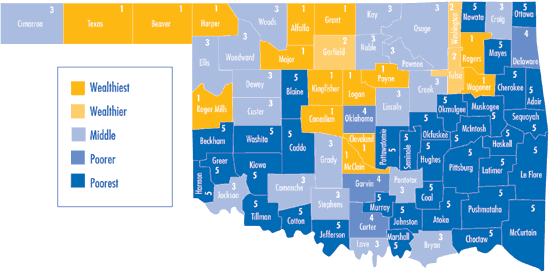|
Introduction Copyright 2004
Oklahoma Institute for Child Advocacy More online information about children at-risk |
Economic Clusters
For the first year since 1999, the 2004 Oklahoma KIDS COUNT Factbook divides Oklahoma’s 77 counties into five clusters with similar conditions based on four economic factors: Child
Poverty Rates (2000 US Census) — Per Capita Personal Income (2000 - 2002 Average Annual) — the most current measure of income levels of people in a community Percent of Children Receiving Temporary Assistance to Needy Families (TANF; FY2001 - FY2003 Average Annual) — the most current measure of children required to survive on inadequate resources Unemployment Rates (2000-2002 Average Annual) — the best measure of people’s ability to improve economic conditions through work Taken together, these factors provide a comprehensive picture of a county’s economic status in a manner which can be ranked, grouped into clusters, updated and tracked from year to year. Each county is ranked on each of the four factors. The four individual county rankings are combined into an “Economic Index” in which the lower the number, the wealthier the county. Each county is ranked again according to its “Economic Index” and grouped into one of five economic clusters: wealthiest, wealthier, middle, poorer or poorest. When compared to the prior years investigated, the economic conditions resulted in placing several Oklahoma counties in a different cluster than in prior years. Each cluster is composed of approximately twenty percent (20%) of the state’s population. These five clusters continue to illustrate the diverse economic environments in which Oklahoma children live. Oklahoma’s wealthiest counties remain primarily concentrated in the northwestern corner of the state, with a few adjacent to Oklahoma’s two largest urban counties (Oklahoma and Tulsa) . The poorest counties remain primarily concentrated in the southeastern corner, with substantial numbers found in the southwest. Similar to past years, the profiles of the five clusters reveal clear patterns in Oklahoma’s economic landscape. Children in Oklahoma’s 35 poorest counties are twice as likely to be poor and twice as likely be on welfare than children in the state’s 15 wealthiest counties. Incomes are the lowest, unemployment rates are the highest, and economic distress is entrenched in these poorest, mostly rural Oklahoma counties. The two clusters of Oklahoma’s 15 wealthiest counties and 3 wealthier have the best indicators in four of the seven benchmark areas investigated by Oklahoma Kids Count. Taken together the economically advantaged areas of Oklahoma have the lowest rates of infants born too small, births to young teens, child abuse & neglect confirmations and juvenile violent crime arrests. Oklahoma’s 15 wealthiest counties also have the lowest Youth Status Index, displaying the best results on indicators measuring conditions for teens and older youth. The two clusters of Oklahoma’s 35 poorest counties and 4 poorer counties have the worst indicators in five of the seven benchmark areas investigated by Oklahoma Kids Count. Taken together the highest rates of infants born too small, infant mortality, births to young teens, child abuse & neglect confirmations and juvenile violent crime arrests are found in these economically disadvantaged areas. The two clusters of Oklahoma’s 35 poorest counties and 4 poorer counties virtually tied for the highest Youth Status Index, displaying the worst results on indicators measuring conditions for teens and older youth.
|




